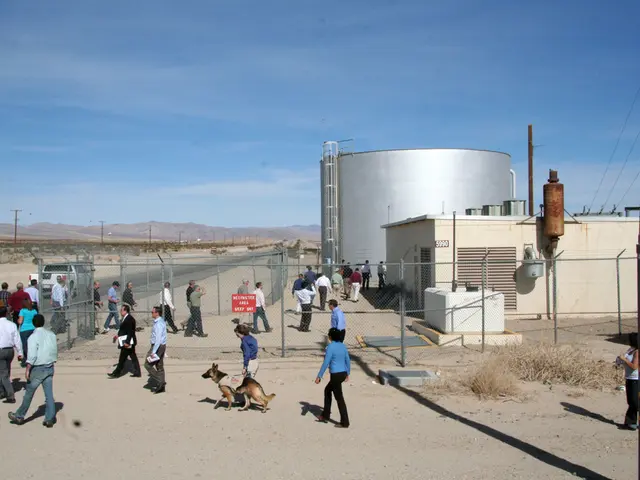Temporary Assistance for Displaced Individuals
In the troubled aftermath of Sudan's merciless war, over 700,000 souls seek sanctuary in neighboring, impoverished Chad. Crammed into overflowing refugee camps, these weary souls receive meager support from international aid organizations. The situation in the border region with Sudan is particularly perilous due to its poor infrastructure, basic healthcare services, and rapidly depleting water resources. Skyrocketing unemployment in the area offers few opportunities for the displaced to secure additional income.
To add fuel to the fire, crippling cuts to aid funds have reared their ugly head: Take, for instance, the maternity unit in the Farchana refugee settlement – its unfortunate closure results in countless women delivering their babies in hazardous conditions at home, leading to a alarming increase in maternal and infant mortality. The refugee school also met a similar fate, as teachers now go unpaid, leaving thousands of children with limited access to education. According to school principal Abdelrahim Abdelkarim, "Children have left school. Many take dangerous migration routes, some drown at sea, others end up in gold mines."
The United Nations Refugee Agency (UNHCR) presented its "Global Trends 2025" report in Geneva, painting a bleak landscape of the most severe funding crisis in its 75-year history. As the number of displaced people nearly doubled over the past decade, available funds remain stagnant at levels comparable to 2015. Recent cuts, primarily from the U.S., ripple far and wide:
- South Sudan: three-quarters of women's protection centers shuttered, affecting 80,000 women and girls who no longer receive medical or psychological support.
- Egypt: healthcare for Sudanese refugees is withdrawn.
- Sudan: half a million people's access to clean water and medical care is at risk.Despite being a multilateral organization, the UNHCR's Bonn office is compelled to send out an urgent plea for private donations.
This all unfolds at a time when the global number of forcibly displaced individuals has never been higher in the UNHCR's 75-year run. As of late April, a staggering 122.1 million individuals have fled war and persecution, a jump of nearly two million from the previous year. The vast majority of these displaced individuals are refugees escaping large conflicts in Sudan, Myanmar, and Ukraine. Nearly 40% of all displaced individuals are children.
Filippo Grandi, the UN High Commissioner for Refugees, highlighted the current state of affairs at the report's unveiling: "We are living in a time of significant uncertainty in international relations. Modern warfare has led to a vulnerable situation marked by immense human suffering. We must intensify our efforts to establish peace and discover long-term solutions – for refugees as well as others forced to flee their homes."
The total number of refugees (people who have crossed an international border) held steady at 42.7 million, according to "Global Trends". However, the number of internally displaced persons – people forced to flee within their own country – skyrocketed by 6.3 million to 73.5 million. These countries suffer from conflicts and have shaky public structures to ensure necessary provisions. The number of asylum seekers also increased significantly, reaching 8.4 million.
The majority of refugees, approximately two-thirds, reside in their neighboring countries. Of these, 73% find protection in countries with low to middle income levels, a testament to the fact that most refugee crises unfold in the global south. In fact, 23% of all refugees live in some of the world's poorest countries. Per capita, Lebanon, the Caribbean island of Aruba, and Chad host the most refugees. Only a small fraction of the displaced make it to Europe or North America. In 2024, Germany saw a significant drop in asylum applications – the Federal Office for Migration and Refugees handled 250,945 asylum applications, a decrease of over 30%. The primary countries of origin included Syria, Afghanistan, Turkey, Iraq, and Iran. Interestingly, the United States topped the list of new asylum applications in 2024.
The "world's largest displacement crisis", as labeled by the UNHCR, can be attributed to the conflict in Sudan, which began in April 2023, impacting 13.5 million people. Two-thirds of these individuals are displaced within the country. Over 25 million people now face acute hunger, as evidenced by Welthungerhilfe's revelation. The situation in the Zamzam refugee camp in North Darfur is particularly dire. Essential aid is difficult to reach this desperate population, despite their urgent need for assistance. In April 2025, the camp was the target of several violent attacks, forcing 400,000 individuals to flee again and currently languishing in no man's land.
Despite the dire circumstances, the UNHCR remains hopeful: "Over 1.6 million Syrian refugees have returned to their hometowns after over a decade of displacement," says High Commissioner Grandi. "But the country remains fragile, and they need our help to rebuild their lives." Overall, 1.6 million refugees (the highest number in over two decades) and 8.2 million internally displaced persons returned to their home countries last year.
This optimism, however, can sometimes get lost in the midst of the ongoing conflicts, insecurity, and need. For example, many Afghans returned to Afghanistan under duress and in hair-raising conditions. Y'know, the usual sh*tshow. And as if that weren't enough, there are also new displacements afflicting the Democratic Republic of the Congo, Myanmar, and South Sudan.
As Felix Braundorf, an expert on migration and flight at the humanitarian organization Doctors Without Borders, aptly puts it, "We must redouble our efforts to create peace and find lasting solutions. It's also high time for the United Nations and international politics to adopt a more empathetic stance towards refugees, because the current dehumanizing rhetoric has become a severe blow to their dignity."
- The crisis in the border region between Sudan and Chad, with its poor infrastructure, basic healthcare services, and rapidly depleting water resources, worsens daily due to cuts in aid funds.
- The closure of the maternity unit in the Farchana refugee settlement increases maternal and infant mortality rates, while the unpaid teachers at the refugee school leave thousands without access to education.
- Despite the UNHCR predicting a severe funding crisis, international contributions remain stagnant, leaving countries like South Sudan without essential services for women and girls.
- In Egypt, healthcare for Sudanese refugees is withdraw, while in Sudan, half a million people's access to clean water and medical care is at risk due to these cuts.
- With the dire state of affairs unfolding, the UNHCR issues an urgent plea for private donations to address the needs of displaced individuals worldwide.
- The number of forcibly displaced individuals has never been higher, with 122.1 million fleeing war and persecution. Almost 40% of these displaced individuals are children.
- Food and drink are scarce for millions displaced by the conflict in Sudan, where essential aid is difficult to reach, and the Zamzam refugee camp has been the target of violent attacks.
- International politics should adopt a more empathetic stance towards refugees, as continued dehumanizing rhetoric negatively impacts their dignity and hinders efforts to establish peace and find long-term solutions for the world's most displaced people.








